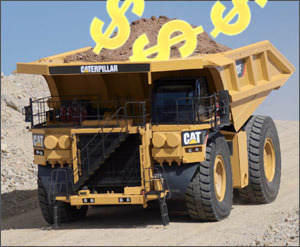Mines fire back on claims of massive subsidy
 Two states’ minerals councils have lobbed volleys at The Australia Institute, accusing it of fudging its numbers to fight an ideological war.
Two states’ minerals councils have lobbed volleys at The Australia Institute, accusing it of fudging its numbers to fight an ideological war.
The Queensland Resources Council and the NSW Minerals Council have slammed the latest anti-mining report by The Australia Institute (TAI), labelling it a sham.
The minerals groups accuse TAI of trying to undermine the industry by reporting royalties lower than they really are and overstating how much it is subsidised.
The NSW Minerals Council says the TAI report Mining in the Age of Entitlement (PDF) published “blatant misinformation” which “significantly misrepresented the facts” with its claim that the mining industry has been given $17.6 billion in government subsidies in the last six years.
The resources lobby commissioned its own opposing report (available in PDF from Castalia Strategic Advisors), which uncovered seemingly inaccurate figures in TAI’s original document.
Michael Schur, from Castalia and former head of the NSW Treasury, says TAI report “grossly exaggerates the level of subsidy to the mining and resources sector” and the analysis of State and Territory budgets “was fundamentally flawed,” he said.
The counter-report found the actual government subsidies “[amount] to no more than a few percentage points of the $17.6 billion claimed by the Institute”.
“The Australia Institute have been clearly caught attempting a massive economic fraud to attack the mining industry,” Mr Schur said.
He argued that “claims were based on a flawed analytical framework, and in the main, unfounded”.
“Behaving commercially is mandatory for government-owned businesses - or public trading enterprises - it is embedded in the legal, policy and institutional frameworks by which they are governed,” Schur said.
“All their expenditure is by definition therefore commercial, and cannot be a subsidy to the mining and resources sector.
“Inexplicably, The Australia Institute claims that about $1 billion in Queensland passenger rail concessions are somehow a subsidy to the mining and resources sector and no logical reason is provided as to why this may be so,” he said.
NSW Minerals Council CEO Stephen Galilee says The Australia Institute should apologise to mine industry workers for attacking their jobs.
Queensland Resource Council chief Michael Roche has detailed some of the findings of the review of TAI’s methods.
He said $14 billion what TAI claimed was a subsidy was actually spent on roads, rail, port, water, electricity and infrastructure, from which the government generates income. The remaining $3.6 billion TAI said was given as a subsidy was not associated with the mining and resources sector at all, Roche said.
The QRC head said TAI’s report contained other factual errors including;
- claiming the capital cost of works at the Meandu coal mine (supplying the Tarong power station) is being taken back in the form of electricity charges, when in reality the government owns both the mine and the power stations;
- claiming about $1 billion worth of rail infrastructure concessions between 2012 and 2014 were for mining, when in fact it was to subsidise passenger transport and loss-making regional freight services
- allegations of subsidies for a barge landing at Aurukun, where no mine currently exists.
TAI spokesperson Rod Campbell has admitted there were mistakes in the Institute’s recent estimates. But he maintains that the more important issue is the difference between the need to protect coal mining as an economic driver versus its actual contribution and cost.







 Print
Print